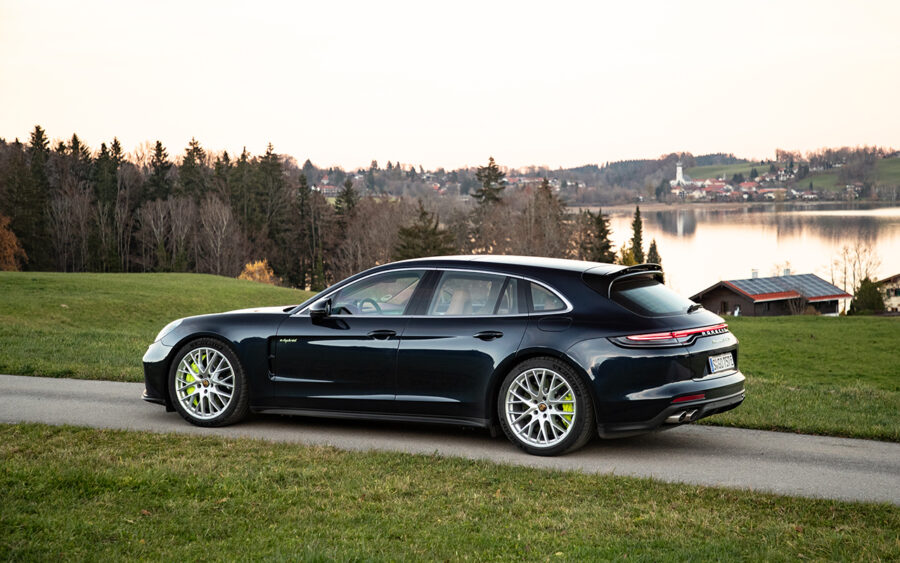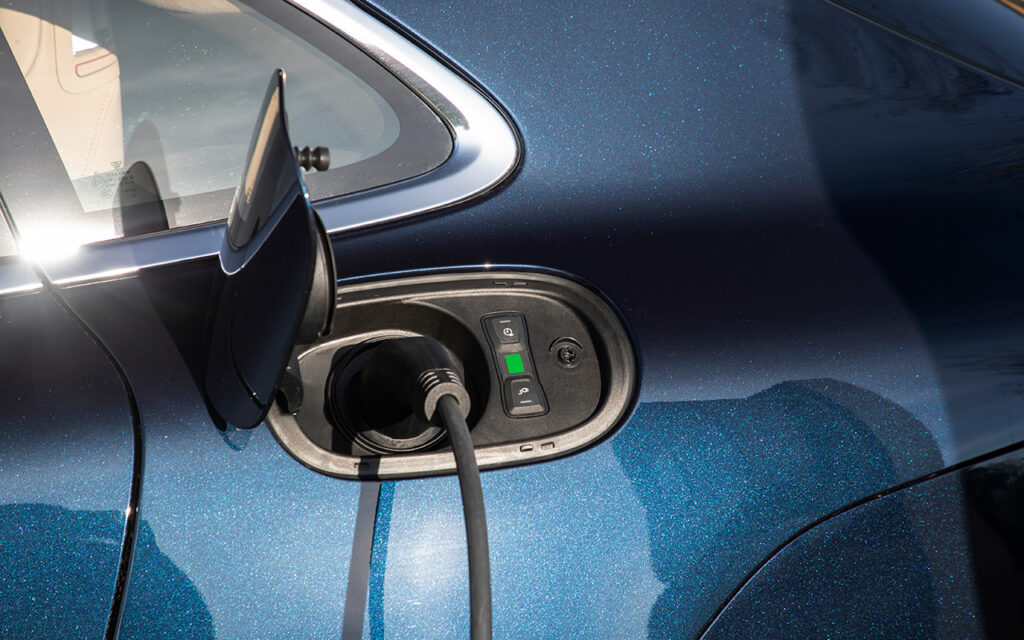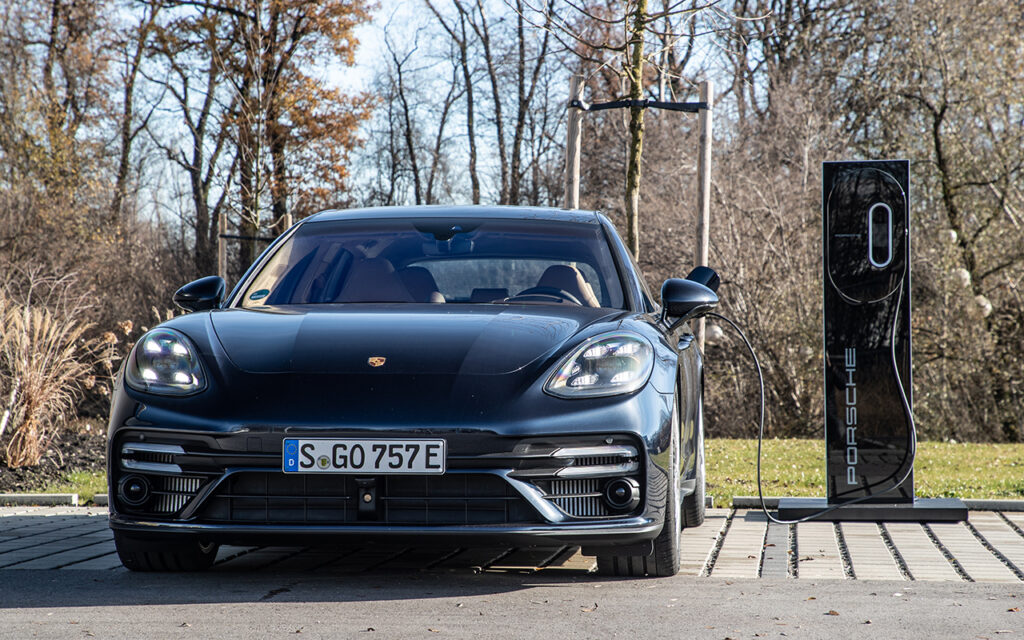Porsche has plenty of hybrid-powered racing history under its belt – but what about performance shooting-brake estates?
If the all-electric Porsche Taycan Turbo Cross Turismo’s theoretical maximum driving range of 281 miles isn’t quite enough, Porsche’s ultimate plug-in hybrid electric vehicle (PHEV) offers a slightly different take on the mega-performance, zero-emissions wagon. Enter the Panamera Turbo S E-Hybrid Sport Turismo.
With a name tripping gaily along for a full fourteen syllables (not counting the two in Porsche), it’s a heck of a mouthful just to say the TSEH ST’s moniker out loud. But then, it’s a heck of a confluence of various automotive streams of ability, isn’t it? Indeed, what we have here is a PHEV estate with seven hundred horsepower at its disposal. Of course, we report outputs in good ol’ imperial brake horsepower here at 911 & Porsche World, meaning peak is 690bhp, but 700PS sounds that little bit more gobsmacking, doesn’t it?! Seriously, the fact Porsche is now offering not one, but a trio of estate cars with comfortably in excess of 650bhp is just… well, we don’t know if there’s a word to sum it up, not least because all three of these mega-power wagons uses electricity as their driving force, to some degree.
Of course, the TSEH ST isn’t an all-new model. The punchiest of PHEVs was around before the second-generation 971 G2 Panamera received its facelift in 2020, but this is where we’re already scratching our heads a little bit about the exact purpose and nature of the top-dog Pan. You see, prior to the facelift, the TSEH sat above the pure-petrol Panamera Turbo. That car had a 543bhp four-litre biturbo V8. Developing 568lb-ft, it was serious potency, we’re sure you’ll agree. The TSEH, however, simply added a 100kW (134bhp) electric motor to the mix to ramp up peak outputs to 671bhp and 627lb-ft, making a decent 128bhp gap between the two cars. This time around, the Panamera Turbo has been replaced by the Turbo S, which uses the same four-litre biturbo V8, only now enhanced to a robust 621bhp and 605lb-ft. Marvellous. Yet, if you’re immediately thinking “if Porsche has now added the 100kW motor again, we could be looking at huge numbers”, then this is where we disappoint you.
As you already know, it’s not as if the TSEH ST v2.0 is deploying 750bhp or thereabouts. No, in fact, compared to the pre-facelift model, it has been granted a mere 19bhp upswing to its latest 690bhp station. And the torque is completely unchanged from before. We can hardly believe we’re saying this about a car with 690bhp, 627lb-ft, a zero to 62mph time of 3.2 seconds (with the romp from rest to 100mph despatched in a scandalous 7.3 seconds) and a top speed of 196mph (those last two metrics both representing 0.2s and 4mph improvements over the old TSEH ST), but we kind of wish Porsche had gone a bit further with the ultimate PHEV Panamera. Now the Turbo S has so much grunt, there needed to be more clear air between this plug-in flagship and the next model down the hierarchical ladder. Indeed, the supposedly ‘lesser’ Turbo S is actually a tenth quicker to 62mph than this car, with a 3.1-second sprint, helped by a significant weight advantage of 230kg — the Turbo S clocks in at a portly 2,210kg overall, but the TSEH ST is a whopping 2,440kg, which is essentially SUV money.

Perhaps playing in the TSEH ST’s favour is the fact there’s only a £4,530 price walk to go from the charms of the pure V8 model to this petrol-electric version’s position of unmatched status. That’s not a massive financial chasm and if, somehow, you can use the TSEH ST’s remarkable on-paper stats of 69g/km CO2 emissions and 94.2mpg in your favour through some sort of company car scheme, or if you place immense stock on being able to whirr around in near-total-silence on electric power only for up to thirty miles, then the TSEH ST starts to make much more sense.
That said, we’re still talking about a car which costs almost £145,000. And once £17,462 of options are added, including a panoramic glass roof (£1,581), the Sport Design Package (£3,117), the Sports exhaust system (£2,537), the Porsche Dynamic Light System Plus (PDLS Plus, £1,166), adaptive cruise control (£1,455), adaptive Sports seats with eighteen-way electric adjustment and memory functionality (£1,053), and an interior package in leather (£1,419) among more sundry items, then the price escalates to a giddy £162,392. It’s that figure, plus the emergence and existence of some of the aforementioned alternative models in the Porsche range, that leaves us feeling somewhat cool on the TSEH ST. Which is not to say that this is a lacklustre car, because it’s anything but. In fact, it’s bloody tremendous. Like any Panamera Sport Turismo, the sleek styling is wonderful and the tidy visual tweaks of the G2 facelift in 2020 only polish the Porsche’s exterior that touch more effectively.
The double-bar LED strips in the front bumper and the full-width, reprofiled light array at the rear are the key hallmarks, but whether you spot this as an updated model or not, the 971-series Panamera looks thoroughly magnificent in this sort of specification. Ditto the interior, which is a masterpiece of quality and ergonomics, liberally splashed with ‘Turbo S’ graphics and various hybrid-related displays and buttons to remind you this is a part-electric car. The TSEH ST comes with the 4+1 seating array as standard and its longer roofline results in greater rear-passenger headroom than in the saloon Panamera. It remains a practical car, although boot space isn’t what you’d call enormous.
With 418 litres on offer (with all seats in play) and 1,287 litres maximum with the second row folded down, it’s an adequate load-lugger rather than a cavernous one. It’s important to note this version of the TSEH ST loses eight litres of space in the cargo area to the pre-facelift PHEV — more on that in a mo — while a non-plug-in Sport Turismo will swallow 487 litres with a full complement of humans aboard and 1,356 litres maximum. In other words, when it comes to buying a new car, if you need carrying capacity more than anything else, the TSEH ST is not the model to choose.
The marginally reduced boot is a consequence of the TSEH ST receiving a larger battery as part of the updates. Yup, you don’t get much more power and the electric motor is totally unchanged, but the battery pack goes from the previous 14.1kWh to 17.9kWh in this version. This allows Porsche to claim an all-electric driving range of thirty miles on the WLTP cycle, although, in reality, you’re going to be looking at more like twenty miles in warmer months and probably notably less in the cold, dark depths of winter. Having said this, we’re not on a downer with the zero-emissions part of the TSEH ST’s make-up. Optioned with Panamera Sport Design alloys for a cost of £411, the ride quality on the adaptive air-sprung, Porsche Active Suspension Management-damped chassis is out-of-this-world good. Rarely does the vehicle become discombobulated by poorer road surfaces and, like any good, top-end prestigious German performance machine, it’s utterly imperious at motorway speeds. With a fully charged battery pack at the start of your journey, the TSEH ST feels like the sensible way to get your near-200mph estate kicks.

You also won’t lose faith in it when you decide to start asking the 5,049mm-long, 1,937mm-wide (excluding the mirrors) Panamera to behave like a 911. Make no mistake, it always feels like a physically big car when you’re on tighter back roads and there’s traffic coming in the opposite direction, but the sensation of hauling in 2.45 tonnes of hard-charging wagon on brakes which also have to do a good amount of energy-regeneration work never once becomes sketchy.
Standard-fit Porsche Ceramic Composite Brake (PCCB) ten-piston aluminium monobloc callipers at the front and four-piston rear shoes see to it the TSEH can shed speed just as impressively as it can rapidly accumulate it, while wonderful steering — augmented by Rear Axle Steering and Power Steering Plus from the factory — allows the Panamera to pivot neatly and invigoratingly into a corner, holding a tenacious line as the Porsche Dynamic Chassis Control Sport (PDCC Sport) keeps the body on an even keel.
And it’s quick. Blimey, it’s quick! When we drove a 671bhp Cayenne Turbo S E-Hybrid, it felt like a cumbersome and almost planetary mass we were trying to hustle into corners, no matter how good the super-SUV’s chassis engineering was. It also didn’t feel monumentally speedy in a straight line, chiefly because you had to await the slightly slovenly responses of several serious bits of hardware (the two turbos on the V8, the eight-speed Tiptronic S torque-converter auto and the electric motor) before you got the full haymaker hit of 664lb-ft. The Panamera TSEH ST proved itself to be a much more agile and rewarding beast in the corners, and it gave the impression of being startlingly faster for acceleration. This is odd because there’s only fifty kilograms between this estate and the top-of-the-line Cayenne PHEV.
With a pleasingly raucous and muscular retort from the Sports exhaust system, plonking down the throttle in the Panamera TSEH ST sees the estate car firing forward with strident alacrity. Disregard that searing 3.2-second 0-62mph time, which is undoubtedly fabulous, but does rather mask the sensation of inertia getting 2,440kg of metal moving sharpish involves, because the more telling stat here is the fact this thing will go from 50-75mph in-gear in a mere 2.1 seconds. Once rolling, the V8-powered Panamera is simply devastatingly gifted in the midrange.
The problem is, though… so is the 621bhp Turbo S. And, in fact, we’d advocate you look even further down the Sport Turismo tree for particularly juicy ‘low’-hanging (relatively speaking) fruit in the form of the GTS. Both models have access to the same four-litre V8 and both are more alert, more richly rewarding and more detailed in the corners than the TSEH ST. And don’t go thinking the PHEV model can save itself with drastically reduced running costs, because the reality is that across 460 miles of testing, we saw an average 31.5mpg. Granted, that’s not bad for a 700hp (sorry, 690bhp) family-transporting blunderbuss like this, but it isn’t exactly transcendental from what a Turbo S would give you if driven reasonably. That our best economy figure in the week of testing was only 48.5mpg on local roads tells its own story of the claimed 94.2mpg on paper.
What we’re trying to say here is that the TSEH ST really is a case of jack of all trades… and master of none. Technically speaking, it’s an astonishing bit of engineering and all things to all people in one glorious, Panamera-estate-shaped creation. There’s no doubt it’s a cracking car in many of the most important aspects which matter to buyers of this type of machine. In truth, however, both the GTS and Turbo S relations to this model do everything you could want of a high-performance wagon, only they’ll be better on running costs for a wider spread of society — unless you plug in your plug-in hybrid on a regular basis, the TSEH ST is somewhat surplus to requirements. And the arrival of the sensational Taycan Turbo S Cross Turismo also ably demonstrates that if you really want to do your bit to save the planet, all while still going like the absolute clappers, the zero-emissions Porsche is it.















